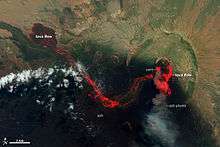Nabro Volcano
| Nabro | |
|---|---|
 False-color topographical relief image of Nabro caldera (top; in Eritrea) next to the Mallahle volcanic caldera (in Ethiopia), then Mount Sarkali with the smaller Sork Ale caldera in the bottom right. | |
| Highest point | |
| Elevation | 2,218 m (7,277 ft) [1] |
| Coordinates | 13°22′N 41°42′E / 13.37°N 41.70°ECoordinates: 13°22′N 41°42′E / 13.37°N 41.70°E [1] |
| Geography | |
 Nabro Eritrea | |
| Location | Southern Red Sea Region, Eritrea |
| Geology | |
| Mountain type | Stratovolcano |
| Last eruption | 2011 to 2012[2] |
The Nabro Volcano is a stratovolcano in the Southern Red Sea Region of Eritrea. It is in the Danakil Depression. Before its 2011 eruption, the volcano was widely believed to be extinct.
Geology
Part of the Afar Triangle, the Nabro Volcano is one of many volcanic caldera complexes in the northeasternmost part of the East African Rift valley region. The twin calderas likely formed during an eruption of about 20 to 100 cubic kilometres consisting of ignimbrite, although the date of their formation is unknown. The subaerial volume of volcanic material within the Nabro Volcanic Range mantle plume is likely on the order of 550 km3.[3]
2011 eruption

Although it had undergone no historically reported eruptions,[4] the Nabro Volcano erupted shortly after midnight local time on 13 June 2011, after a series of earthquakes up to magnitude 5.7 in the Eritrea-Ethiopia border region.[4] The ash plume was seen on satellite drifting to the west-northwest along the border, spanning about 50 km wide and several hundred kilometres across in the hours immediately following the reported eruption, and reportedly reaching 15 km (9.3 mi) high.[4]
On June 13, US Secretary of State Hillary Clinton had to cut short a trip to Ethiopia due to the ash cloud, which was projected to enter a west-to-east jetstream and enter the atmosphere of countries such as Egypt, Yemen, Israel, Iraq, Jordan, Sudan, Somalia, Djibouti and Saudi Arabia.[5][6]
The ash cloud began disrupting air traffic as UAE-based Emirates flights were cancelled along with Saudi Arabian Airlines flights.[7][8] Luxor International Airport in Luxor, Egypt was placed on a state of emergency.[9]
2012 Eruptive Activity
The MODVOLC noted on the 9 April 2012 that a thermal anomaly was detected at Nabro and that such anomalies had been detected throughout March. The activity is focused on the Northern Caldera wall, what sort of activity is unknown, but activolcans.info noted that there might be a lava lake there.
See also
| Wikimedia Commons has media related to Nabro. |
References
- 1 2 "Nabro". Global Volcanism Program. Smithsonian Institution. Retrieved 2007-04-04.
- ↑ Dunphy, Mark (June 13, 2011). "Ash Cloud Spreads From Erupting Nabro Volcano In Eritrea". Irish Weather Online. Retrieved June 13, 2011.
- ↑ Wiart, Pierre; Clive Oppenheimer (25 May 2004). "Large magnitude silicic volcanism in north Afar: the Nabro Volcanic Range and Ma'alalta volcano". Bulletin of Volcanology. 67 (2): 99–115. Bibcode:2005BVol...67...99W. doi:10.1007/s00445-004-0362-x. Retrieved 13 June 2011.
- 1 2 3 "Eruption at Nabro Volcano, Eritrea", NASA Earth Observatory. June 13, 2011. Accessed June 13, 2011
- ↑ "Volcano Eruption in Eritrea cuts short Hillary Clinton visit", The Telegraph. June 13, 2011. Accessed June 13, 2011
- ↑ "Ash Cloud Spreads From Erupting Nabro Volcano In Eritrea", Mark Dunphy. Irish Weather Online. June 13, 2011. Accessed June 13, 2011
- ↑ "Emirates flights to Africa disrupted", Dubai Chronicle. June 14, 2011. Accessed June 14, 2011
- ↑ "Saudi Airlines reschedules flights to Africa due to ash cloud", AME Info. June 15, 2011. Accessed June 15, 2011
- ↑ "Luxor airport prepares for Eritrean volcanic ash cloud", Al-Masry Al-Youm. June 14, 2011. Accessed June 15, 2011
